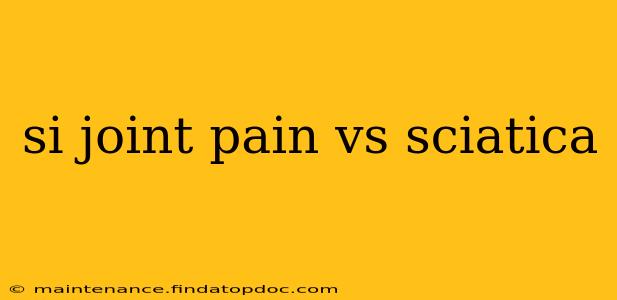Pain in the lower back and buttocks is a common complaint, often leading to confusion between two potential sources: sacroiliac (SI) joint pain and sciatica. While both can cause similar symptoms, understanding the key differences is crucial for accurate diagnosis and effective treatment. This article will delve into the nuances of SI joint pain versus sciatica, helping you better understand the distinctions and when to seek professional medical advice.
What is SI Joint Pain?
The sacroiliac (SI) joints are two strong, slightly movable joints located where the sacrum (the triangular bone at the base of the spine) connects to the ilium (the uppermost part of the hip bone). SI joint pain is characterized by discomfort in the lower back, buttocks, and sometimes the groin or upper thighs. The pain is often localized to the area of the SI joint itself and may worsen with activities that put stress on these joints, such as prolonged sitting, standing, twisting, or lifting heavy objects.
What causes SI joint pain?
Several factors can contribute to SI joint pain, including:
- Injury: Falls, trauma, or repetitive strain can damage the ligaments and cartilage surrounding the SI joint.
- Pregnancy: Hormonal changes during pregnancy can relax the ligaments, making the SI joints more unstable and prone to pain.
- Arthritis: Conditions like osteoarthritis or rheumatoid arthritis can inflame the SI joint, causing pain and stiffness.
- Spondyloarthropathies: These inflammatory diseases can affect the SI joints and other parts of the spine.
- Sacroiliitis: Inflammation of the SI joint, often associated with inflammatory bowel disease.
- Poor posture: Maintaining poor posture can place excess stress on the SI joints.
What is Sciatica?
Sciatica is pain that radiates along the sciatic nerve, the longest nerve in the body. This nerve originates in the lower back, runs through the buttocks, and extends down the back of each leg. Sciatica is often described as a sharp, shooting, burning, or tingling pain that can travel down the leg to the foot.
What causes sciatica?
The most common cause of sciatica is a herniated disc in the lower spine. A herniated disc can compress the sciatic nerve, resulting in pain, numbness, and weakness in the leg. Other causes of sciatica include:
- Spinal stenosis: Narrowing of the spinal canal, which can put pressure on the nerve roots.
- Piriformis syndrome: Irritation or compression of the sciatic nerve by the piriformis muscle in the buttock.
- Spinal tumors: Rarely, tumors in the spine can compress the sciatic nerve.
- Degenerative disc disease: The natural wear and tear of the spinal discs can lead to nerve compression.
SI Joint Pain vs. Sciatica: Key Differences
While both conditions share some overlapping symptoms, several key differences can help distinguish them:
| Feature | SI Joint Pain | Sciatica |
|---|---|---|
| Location | Primarily in the lower back, buttocks, groin | Lower back, radiating down one or both legs |
| Pain Quality | Dull ache, throbbing, stiffness | Sharp, shooting, burning, tingling |
| Leg Involvement | Minimal or no leg pain | Significant leg pain, often extending to the foot |
| Movement | Pain often worsened by weight-bearing activities, twisting, and prolonged sitting or standing | Pain may be worsened by certain movements but can also occur at rest |
| Numbness/Tingling | Usually absent or minimal | Common, often accompanied by weakness |
How are SI Joint Pain and Sciatica Diagnosed?
Diagnosing SI joint pain and sciatica requires a thorough physical examination by a healthcare professional. Imaging tests, such as X-rays, MRIs, or CT scans, may be used to rule out other conditions and confirm the diagnosis. Specific diagnostic tests may also be used to pinpoint SI joint involvement.
Treatment for SI Joint Pain and Sciatica
Treatment options vary depending on the underlying cause and severity of the condition. Common treatments include:
- Conservative Treatments: Physical therapy, pain medication (over-the-counter or prescription), heat or ice packs, rest, and lifestyle modifications (e.g., improving posture).
- Injections: Corticosteroid injections can help reduce inflammation in both SI joint pain and sciatica.
- Surgery: Surgery is typically reserved for severe cases that haven't responded to conservative treatments.
What are the long-term outcomes for SI joint pain and sciatica?
The long-term outlook for both conditions varies greatly depending on the individual and the underlying cause. Many people experience significant improvement with conservative treatment. However, some individuals may experience chronic pain requiring ongoing management.
Can SI joint pain cause sciatica?
While not directly causing sciatica in the typical sense (nerve root compression), significant SI joint dysfunction can indirectly contribute to lower back pain that mimics sciatica or might exacerbate existing sciatica by altering spinal mechanics and increasing pressure on nerve roots. This is a key point of differentiation that requires careful evaluation by a specialist.
This information is for general knowledge and does not constitute medical advice. Always consult a healthcare professional for diagnosis and treatment of lower back pain.
